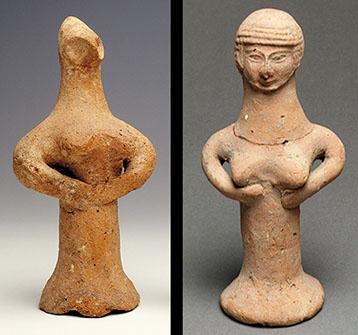Puzzling artifacts from Iron Age Judah

One type of JPF has a face that’s pinched to make two eyes. (Left, Photo: Israel Museum, Jerusalem.) The second major type of JPF has a mold-made head with defined facial features. (Right, Photo: Metropolitan Museum of Art.)
More than one hundred years after they were first discovered, Judean Pillar Figurines remain poorly understood. Judean Pillar Figurines—abbreviated JPFs—were prevalent in Judah during the First Temple period (ca. 800–586 B.C.E.). These household objects disappeared with the Babylonian conquest of Judah in 586 B.C.E.
In “JPFs: More Questions than Answers” in the September/October 2014 issue of Biblical Archaeology Review, Robert Deutsch provides an overview of these puzzling pillar figurines.
To begin, the name “Judean Pillar Figurine”—as these objects are universally called—is somewhat of a misnomer. The land in which these pillar figurines were found was called Judah, not Judea. The name Judea emerged when the southern Levant came under Roman rule beginning in the first century B.C.E. The adjective Judahite—to describe the people and material culture of Judah—is a recent designation. Deutsch therefore believes these Iron Age pillar figurines in question are more accurately represented by the name “Judahite Pillar Figurines.” They are also called JPFs for simplicity.
JPFs are clay female figurines with heads rendered largely in two major types: those that are handmade and those that are mold-made. The handmade heads are fashioned in a rudimentary way, with their faces pinched to form two eyes. The heads made from molds display hairstyles resembling Egyptian wigs, with rows of curls, and defined facial features. A solid cylindrical pillar is used for the bodies of both types of JPFs. Both types also have oversized breasts, under which the arms curve.
The form, function and symbolism of these pillar figurines have been heavily debated, with many questions still remaining. Archaeologist Raz Kletter, who is considered an authority on JPFs, believes the figurines represent Asherah—a Canaanite goddess whom some scholars contend was worshiped as God’s wife or consort. Others have suggested, however, that JPFs represent the goddesses Astarte or Anath. Further, were JPFs fertility goddesses? Good-luck charms? Toys? The scholarly community has not reached a consensus.